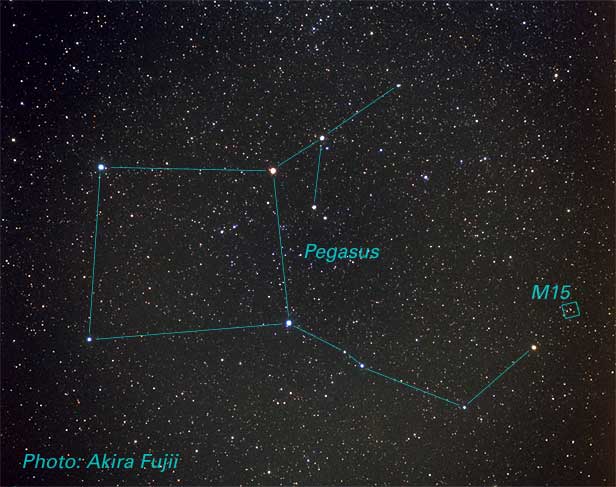Pegasus Constellation: Facts & Notable Features
Pegasus is a prominent constellation in the northern sky, named after a winged horse in Greek mythology. The constellation is one of the older ones known in the night sky: It is one of the 48 constellations listed by the second-century astronomer Ptolemy. Today, Pegasus is one of the 88 constellations officially recognized by the International Astronomical Union (IAU).
In the Northern Hemisphere, the constellation is high in the sky starting near the end of summer and continuing through autumn. If you are below the equator, look for Pegasus in late winter and through spring.
The constellation is famous for hosting the first exoplanet ever found around a normal star, as well as a galaxy known as M15.
Major stars
When observers look at the constellation Pegasus, the part that stands out is the Square of Pegasus – a major asterism, or group of stars that is smaller than a constellation. The square is made up of four stars that are of nearly equal brightness, when seen from Earth. These four stars are named Scheat, Alpheratz, Markab and Algenib.
The brightest star in the constellation is Epsilon Pegasi, which forms the nose, according to Jim Kaler, an astronomer and professor emeritus at the University of Illinois.
Another star in this constellation, 51 Pegasi b, is the first sun-like star known to have a planet orbiting around it. The planet is roughly 50 light-years away from Earth and is classified as a "hot Jupiter" – a planet that is Jupiter-size and orbits close to its parent star. The visible light spectrum of 51 Pegasi b's atmosphere was observed in 2015. In that same year, the IAU announced that it would also call 51 Pegasi b by the name Dimidium, following a public vote.
Clusters of galaxies
Among Pegasus’ more remarkable features are its numerous galaxies and objects.
Pegasus contains a Messier object, named M15, which is a cluster of stars that are about 34,000 light-years from Earth. M15 is one of the most densely packed clusters in the Milky Way galaxy.
NGC 7331 is a spiral galaxy within Pegasus that is between 36 million to 46 million light-years from Earth. In 2014, astronomers spotted a supernova in this galaxy that released more hydrogen and heavier elements than expected, shortly before it exploded. Michael J.I. Brown, an observational astronomer at Monash University in Australia, wrote that NGC 7331 is close to the Milky Way in shape, which makes the galaxy an interesting object when astronomers make comparisons with our own neighborhood.
The Einstein Cross, a quasar, is an excellent example of gravitational lensing – the process by which distant objects are magnified by the gravity of closer objects. The quasar is about 8 billion light-years from Earth and sits behind a galaxy that is 400 million light-years away. Four images of the quasar appear around the galaxy because the intense gravity of the galaxy bends the light coming from the quasar.

Pegasus' position
Pegasus is best seen in October, at 9 p.m. local time.
- Right ascension: 22 hours
- Declination: 20 degrees
- Visible between latitudes 90 and -60 degrees
Mythology
The name comes from the winged white horse that was the sire of Poseidon in Greek mythology. The story of Pegasus begins with a battle between Perseus and Medusa. One day, the warrior Bellerophon tried to ride Pegasus to Mount Olympus, enraging Zeus so much that he sent a gadfly to bite Pegasus. When the horse was stung, Bellerophon fell to the Earth. Pegasus made it to Olympus. [How the Night Sky Constellations Got Their Names]
This article was updated on Nov. 9, 2018, by Space.com Contributor, Elizabeth Howell.
Join our Space Forums to keep talking space on the latest missions, night sky and more! And if you have a news tip, correction or comment, let us know at: community@space.com.
Breaking space news, the latest updates on rocket launches, skywatching events and more!
Kim Ann Zimmermann is a contributor to Space.com and sister site Live Science, writing mainly evergreen reference articles that provide background on myriad scientific topics, like the constellations, astronauts, climate, culture and medicine. Her work can also be found at Business News Daily and KM World. She holds a bachelor’s degree in communications from Glassboro State College.
